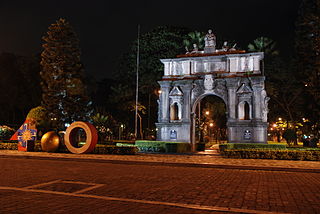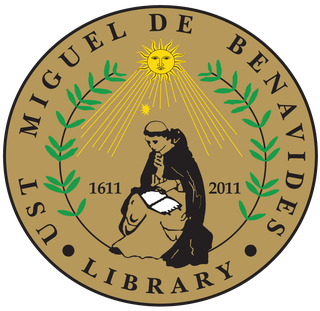Baybayin is a Philippine script. The script is an abugida belonging to the family of the Brahmic scripts. Geographically, it was widely used in Luzon and other parts of the Philippines prior to and during the 16th and 17th centuries before being replaced by the Latin alphabet during the period of Spanish colonization. It was used in the Tagalog language and, to a lesser extent, Kapampangan-speaking areas; its use spread to the Ilocanos in the early 17th century. In the 19th and 20th centuries, baybayin survived and evolved into multiple forms—the Tagbanwa script of Palawan, and the Hanuno'o and Buhid scripts of Mindoro—and was used to create the constructed modern Kulitan script of the Kapampangan and the Ibalnan script of the Palawan people. Under the Unicode Standard and ISO 15924, the script is encoded as the Tagalog block.

The University of Santo Tomas (UST), officially the Pontifical and Royal University of Santo Tomas, Manila, is a private, Catholic research university in Manila, Philippines. Founded on April 28, 1611, by Spanish friar Miguel de Benavides, third Archbishop of Manila, it has the oldest extant university charter in Asia and is one of the world's largest Catholic universities in terms of enrollment found on one campus. It is the main campus of the University of Santo Tomas System that is run by the Order of Preachers.

The Arch of the Centuries is a triumphal arch at the Plaza Intramuros of the University of Santo Tomas (UST) in Manila, in the Philippines that stands meters away from the university's Millennium Gate along España Boulevard. Half of the current structure, the side facing the UST Main Building is the ruins of the original Intramuros arch while the side that faces España Boulevard is a replica. The arch was formerly the original entrance to the university when the campus was still in Intramuros during the years from 1680 to 1941. It was declared by the National Museum as a National Cultural Treasure on 25 January 2010.

The Maragtas is a work by Pedro Alcantara Monteclaro titled History of Panay from the first inhabitants and the Bornean immigrants, from which they descended, to the arrival of the Spaniards. The work is in mixed Hiligaynon and Kinaray-a languages in Iloilo in 1907. It is an original work based on written and oral sources available to the author.

The University of Santo Tomas in Manila, Philippines marks a variety of traditions largely influenced by the Spanish and Filipino Dominican culture. Many are annual events, such as religious assemblies marking the start and end of the academic year, a welcome walk for new students, as well as intercollege sport competitions and talent exhibitions. Christmas is celebrated in a month-long festivities culminated by the UST Paskuhan. Many Roman Catholic feast days are also celebrated.
The Pontifical and Royal University of Santo Tomas (UST) celebrated its 400th anniversary in 2011. The agenda before the quadricentennial in 2011 included the introduction of new academic programs, improvements in the university's infrastructure, and other projects to raise UST's national and international prominence and promote its role as a social catalyst.

University of Santo Tomas Publishing House (USTPH) is a Filipino academic and literary publishing house. USTPH, in its current form, was established in 1996. It was inspired by the four-century-old UST Press, which was founded in 1593. USTPH, formerly the UST Press, is the oldest continuing press in Asia today. It is even older than the University of Santo Tomas, which was established in 1611. At present, it is equipped with high quality printing machines from Germany and advanced computer technology from the United States, Japan, and other countries. The USTPH aims to provide extensively the creative and innovative outputs of the academe, not only within, but also outside the campus.

During the Spanish colonial period in the Philippines (1521–1898), the different cultures of the archipelago experienced a gradual unification from a variety of native Asian and Islamic customs and traditions, including animist religious practices, to what is known today as Filipino culture, a unique hybrid of Southeast Asian and Western culture, namely Spanish, including the Spanish language and the Catholic faith.

The Doctrina Christiana were two early books on the catechism of the Catholic Church, both published 1593 in Manila, Philippines. These are two of the earliest printed books in the Philippines.

The Miguel de Benavides Library, also known as the University of Santo Tomas Library, is the main academic library of the University of Santo Tomas. The library has been in continuous service and its collection antedates the existence of the university itself.

Kulitan, also known as súlat Kapampángan and pamagkulit, is one of the various indigenous suyat writing systems in the Philippines. It was used for writing Kapampangan, a language mainly spoken in Central Luzon, until it was gradually replaced by the Latin alphabet.
This is a timeline of the history of the Pontifical and Royal University of Santo Tomas, the oldest university in Asia, comprising important events of the history of the university and of the development of Philippine higher education in general. To read about the background to these events, see History of the University of Santo Tomas. See also the history of the Rector Magnificus of the University of Santo Tomas, and the Santo Tomas Internment Camp

The University of Santo Tomas Central Seminary Building currently houses the Santísimo Rosario Parish, the Central Seminary, and the Faculties of Ecclesiastical Studies of the Pontifical and Royal University of Santo Tomas in Manila. The parish was canonically inaugurated on April 26, 1942, by Michael J. O'Doherty, the Archbishop of Manila. On January 25, 2010, the National Museum of the Philippines formally declared the Central Seminary Building as a National Cultural Treasure.
Old Tagalog, also known as Old Filipino, is the earliest form of the Tagalog language during the Classical period. It is the primary language of pre-colonial Tondo, Namayan and Maynila. The language originated from the Proto-Philippine language and evolved to Classical Tagalog, which was the basis for Modern Tagalog. Old Tagalog uses the Tagalog script or Baybayin, one of the scripts indigenous to the Philippines.

The University of Santo Tomas Baybayin Documents or UST Baybayin Documents are two 17th century land deeds written in Baybayin script.
The UST Christmas Concert is an annual musical event of the University of Santo Tomas in Manila, Philippines.

The archaeology of the Philippines is the study of past societies in the territory of the modern Republic of the Philippines, an island country in Southeast Asia, through material culture.
Suyat is the modern collective name of the indigenous scripts of various ethnolinguistic groups in the Philippines prior to Spanish colonization in the 16th century up to the independence era in the 21st century. The scripts are highly varied; nonetheless, the term was suggested and used by cultural organizations in the Philippines to denote a unified neutral terminology for Philippine indigenous scripts.
Michael Anthony Vasco is a Filipino professor and educational administrator.
























